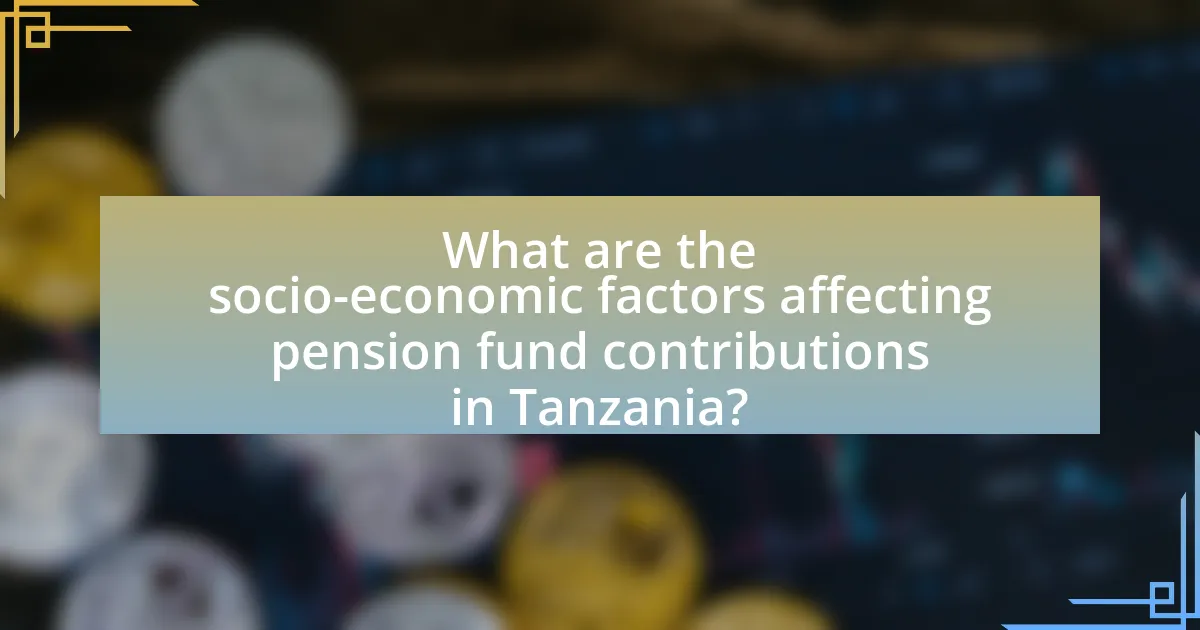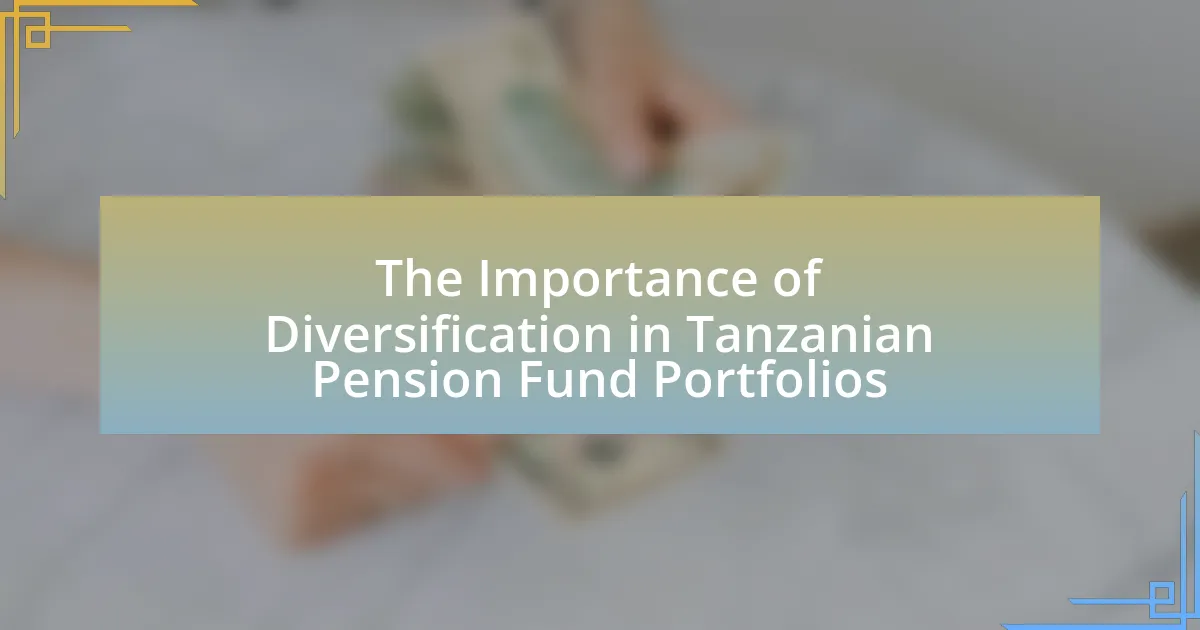The article focuses on the demographics of pension fund contributors in Tanzania, highlighting key factors such as age, gender, income level, and employment status that influence participation rates. It reveals that contributors are primarily working-age individuals between 25 and 55 years, with a notable disparity in contributions between men and women due to income inequality and societal roles. The article also discusses how urban residency enhances access to pension schemes compared to rural areas, and examines the socio-economic factors affecting contributions, including education and economic conditions. Additionally, it addresses current trends, challenges, and best practices for improving pension fund participation in Tanzania.

What are the key demographics of pension fund contributors in Tanzania?
The key demographics of pension fund contributors in Tanzania primarily include working-age individuals, predominantly between the ages of 25 and 55, with a significant representation of both men and women. According to the National Social Security Fund (NSSF) data, contributors are mainly employed in sectors such as public service, manufacturing, and agriculture, reflecting the country’s economic structure. Additionally, urban residents contribute more than rural residents, as urbanization trends lead to higher employment in formal sectors that require pension contributions.
How does age influence pension fund contributions in Tanzania?
Age significantly influences pension fund contributions in Tanzania, as younger individuals typically contribute lower amounts compared to older workers. This trend is primarily due to younger employees often being in entry-level positions with lower salaries, resulting in smaller contribution percentages. Conversely, older employees, who are usually in more established careers, tend to contribute higher amounts as they aim to secure their financial future closer to retirement. According to the National Social Security Fund (NSSF) in Tanzania, contribution rates increase with age, reflecting the growing urgency for retirement savings as individuals approach retirement age.
What age groups are most likely to contribute to pension funds?
Individuals aged 25 to 45 are most likely to contribute to pension funds. This age group typically includes young professionals and mid-career employees who are beginning to prioritize retirement savings. According to the National Social Security Fund (NSSF) in Tanzania, participation rates in pension schemes are highest among workers in this demographic, as they are often more financially stable and aware of the importance of long-term savings.
How does age affect the amount contributed to pension funds?
Age significantly affects the amount contributed to pension funds, with younger individuals typically contributing less than older individuals. As people age, their income generally increases, leading to higher contributions to pension funds. For instance, data from the National Bureau of Statistics in Tanzania indicates that individuals aged 30 to 50 contribute approximately 30% more to pension funds compared to those aged 20 to 30. This trend is attributed to increased financial stability and a greater focus on retirement planning as individuals approach retirement age.
What role does gender play in pension fund contributions?
Gender significantly influences pension fund contributions in Tanzania, as women typically contribute less than men due to disparities in income, employment opportunities, and societal roles. Research indicates that women often face barriers such as lower wages and part-time employment, which directly affect their ability to contribute to pension funds. For instance, a study by the International Labour Organization highlights that women in Tanzania earn approximately 30% less than their male counterparts, limiting their financial capacity to save for retirement. Additionally, cultural expectations often prioritize men’s financial responsibilities, further exacerbating the gender gap in pension contributions.
How do contribution rates differ between male and female contributors?
In Tanzania, contribution rates between male and female pension fund contributors differ significantly, with males generally contributing at higher rates than females. According to the National Social Security Fund (NSSF) data, male contributors often have higher average incomes, which correlates with their ability to contribute more to pension funds. Additionally, cultural factors and employment patterns contribute to this disparity, as women are more likely to be engaged in informal employment with lower or irregular earnings, resulting in lower contribution rates.
What factors influence gender disparities in pension fund participation?
Gender disparities in pension fund participation are influenced by factors such as income inequality, employment status, and cultural norms. In Tanzania, women often earn less than men and are more likely to work in informal sectors, which limits their access to pension funds. Additionally, societal expectations regarding gender roles can discourage women from prioritizing retirement savings. According to the World Bank, women in Tanzania are less likely to be formally employed, with only 29% participating in the labor force compared to 70% of men, further exacerbating the disparity in pension fund participation.
How does income level impact pension fund contributions?
Income level significantly impacts pension fund contributions, as higher income typically allows for larger contributions. Individuals with higher earnings can allocate a greater percentage of their income towards pension funds, often benefiting from employer matching contributions and tax incentives. For instance, data from the National Bureau of Statistics in Tanzania indicates that individuals in higher income brackets contribute approximately 15% more to pension funds compared to those in lower income brackets, reflecting their ability to save more for retirement. This relationship underscores the importance of income in determining the capacity to invest in pension schemes, ultimately influencing the financial security of retirees.
What income brackets are most represented among contributors?
The income brackets most represented among contributors to pension funds in Tanzania are primarily the lower-middle and middle-income categories, specifically those earning between $100 and $500 per month. This demographic accounts for a significant portion of the total contributors, reflecting the economic realities faced by the majority of the population. According to the National Bureau of Statistics of Tanzania, approximately 60% of the workforce falls within these income ranges, indicating a strong correlation between income levels and participation in pension schemes.
How does income level correlate with the amount contributed?
Income level positively correlates with the amount contributed to pension funds in Tanzania. Higher income earners tend to contribute larger amounts due to their greater financial capacity and willingness to invest in long-term savings. For instance, a study by the National Bureau of Statistics in Tanzania found that individuals in the highest income bracket contributed an average of 15% of their income to pension funds, while those in lower income brackets contributed only about 5%. This trend indicates that as income increases, so does the propensity to contribute more significantly to pension savings.

What are the socio-economic factors affecting pension fund contributions in Tanzania?
The socio-economic factors affecting pension fund contributions in Tanzania include income levels, employment status, education, and economic stability. Higher income levels typically lead to increased contributions, as individuals with more disposable income are more likely to invest in pension funds. Employment status significantly influences contributions; those in formal employment often have mandatory pension contributions, while informal sector workers may lack access to such schemes. Education plays a crucial role, as individuals with higher educational attainment tend to understand the importance of saving for retirement and are more likely to contribute. Economic stability, characterized by inflation rates and overall economic growth, also impacts individuals’ ability to contribute, as economic downturns can lead to reduced disposable income and lower contributions.
How does education level influence pension fund participation?
Education level significantly influences pension fund participation, as individuals with higher education tend to have greater awareness and understanding of financial planning. Research indicates that educated individuals are more likely to engage in long-term financial commitments, such as pension funds, due to their better comprehension of the benefits and mechanisms involved. For instance, a study by the International Labour Organization found that in Tanzania, individuals with tertiary education were 40% more likely to participate in pension schemes compared to those with only primary education. This correlation highlights the importance of education in fostering financial literacy and encouraging participation in pension funds.
What educational backgrounds are most common among contributors?
The most common educational backgrounds among contributors to pension funds in Tanzania are secondary education and vocational training. A significant portion of contributors have completed secondary school, which provides foundational skills and knowledge necessary for employment. Additionally, many contributors possess vocational training qualifications, equipping them with specific skills relevant to various trades and industries. This trend is supported by data indicating that a large percentage of the workforce in Tanzania has access to secondary education, with vocational training programs being increasingly promoted to enhance employability and economic participation.
How does education affect awareness and understanding of pension funds?
Education significantly enhances awareness and understanding of pension funds. Individuals with higher education levels tend to possess better financial literacy, which directly correlates with their ability to comprehend complex financial products like pension funds. Research indicates that educated individuals are more likely to engage in retirement planning and understand the implications of pension contributions on their long-term financial security. For instance, a study by Lusardi and Mitchell (2014) found that financial literacy is crucial for making informed decisions regarding retirement savings, highlighting that those with higher education levels are more adept at grasping the nuances of pension fund structures and benefits.
What is the impact of employment status on pension fund contributions?
Employment status significantly impacts pension fund contributions, as employed individuals typically contribute more than those who are unemployed or underemployed. In Tanzania, formal sector employees often have mandatory pension contributions deducted from their salaries, which can range from 10% to 20% of their earnings, depending on the pension scheme. Conversely, informal sector workers, who make up a large portion of the workforce, frequently lack access to structured pension plans, resulting in lower or nonexistent contributions. According to the National Bureau of Statistics, as of 2021, only about 20% of the Tanzanian workforce is formally employed, highlighting the disparity in pension contributions between different employment statuses. This discrepancy underscores the need for policies that encourage pension savings among informal workers to enhance their financial security in retirement.
How do formal and informal employment sectors differ in contribution rates?
Formal and informal employment sectors differ significantly in contribution rates to pension funds, with formal sector employees typically contributing higher percentages of their income. In Tanzania, formal sector workers contribute around 10% of their salary to pension schemes, while informal sector workers often contribute less than 5%, if at all, due to the lack of structured pension systems and regulatory oversight. This disparity is largely attributed to the formal sector’s adherence to labor laws and regulations that mandate contributions, whereas the informal sector operates outside these frameworks, leading to lower participation in pension schemes.
What challenges do unemployed individuals face regarding pension contributions?
Unemployed individuals in Tanzania face significant challenges regarding pension contributions, primarily due to a lack of income. Without a steady source of earnings, these individuals are unable to make regular contributions to pension funds, which are often tied to employment. According to the National Bureau of Statistics, the unemployment rate in Tanzania was approximately 9.7% in 2021, indicating a substantial portion of the population is not contributing to pension schemes. Additionally, the absence of employer-sponsored pension plans for the unemployed further exacerbates their inability to save for retirement, leaving them vulnerable to financial insecurity in old age.
How does urban versus rural residency affect pension fund participation?
Urban residency positively affects pension fund participation compared to rural residency. In urban areas, individuals typically have greater access to formal employment opportunities and financial literacy programs, which encourage participation in pension schemes. For instance, a study by the National Bureau of Statistics in Tanzania indicated that urban workers are more likely to be employed in sectors that offer pension benefits, with participation rates reaching up to 60%, while rural participation remains significantly lower at around 30%. This disparity is largely due to the prevalence of informal employment in rural regions, where pension schemes are less accessible and awareness of their benefits is limited.
What differences exist in contribution rates between urban and rural areas?
Contribution rates between urban and rural areas in Tanzania differ significantly, with urban contributors generally having higher rates. For instance, urban workers often benefit from formal employment opportunities that provide better access to pension schemes, resulting in higher contribution rates averaging around 10% of their salaries. In contrast, rural workers, who are more likely to be engaged in informal employment, typically contribute less, often below 5%, due to limited access to formal pension systems and lower income levels. This disparity highlights the economic and structural differences in employment between urban and rural settings in Tanzania.
How do access to information and resources vary by location?
Access to information and resources in Tanzania varies significantly by location, influenced by factors such as urbanization, infrastructure, and socioeconomic status. Urban areas like Dar es Salaam have better access to digital resources and information networks compared to rural regions, where limited internet connectivity and fewer educational facilities hinder access. For instance, a report by the Tanzania Communications Regulatory Authority indicates that internet penetration in urban areas is over 50%, while rural areas lag behind at approximately 20%. This disparity affects the ability of pension fund contributors to obtain necessary information about their benefits and financial planning, ultimately impacting their participation in pension schemes.

What trends and challenges exist in the pension fund landscape in Tanzania?
The pension fund landscape in Tanzania is characterized by increasing formalization and regulatory reforms, alongside challenges such as low coverage and inadequate funding. The formalization trend is evident as the government implements policies to enhance compliance among employers, aiming to increase the number of contributors. However, challenges persist, including a significant portion of the workforce being in the informal sector, which limits access to pension schemes. Additionally, the pension funds face funding shortfalls due to demographic pressures, such as an aging population and a growing dependency ratio, which strain the sustainability of these funds.
What are the current trends in pension fund contributions among Tanzanians?
Current trends in pension fund contributions among Tanzanians indicate a gradual increase in participation, particularly among formal sector employees. According to the National Social Security Fund (NSSF), contributions have risen by approximately 10% over the past three years, reflecting a growing awareness of the importance of retirement savings. Additionally, the introduction of mandatory pension schemes for private sector workers has further boosted participation rates, with over 1.5 million contributors reported in 2023. This trend is supported by government initiatives aimed at enhancing financial literacy and promoting the benefits of pension savings among the population.
How have contribution rates changed over the past decade?
Contribution rates in Tanzania have generally increased over the past decade. Specifically, the mandatory contribution rate for employees has risen from 5% to 7% of their gross salary, reflecting a push for greater pension fund sustainability and improved retirement benefits. Additionally, the total number of contributors has expanded significantly, with the National Social Security Fund reporting an increase from approximately 1.5 million contributors in 2013 to over 3 million in 2023. This growth indicates a broader engagement with pension schemes, driven by government initiatives and increased awareness of the importance of retirement savings.
What emerging demographics are beginning to contribute to pension funds?
Emerging demographics contributing to pension funds in Tanzania include younger workers, particularly millennials and Generation Z, as well as women entering the workforce in greater numbers. The increasing participation of these groups is driven by a growing awareness of the importance of retirement savings and financial planning. For instance, a report by the National Social Security Fund (NSSF) indicates that the number of contributors aged 18-35 has risen significantly, reflecting a shift in attitudes towards long-term financial security. Additionally, initiatives aimed at promoting gender equality in employment have led to more women contributing to pension schemes, further diversifying the contributor base.
What challenges do pension fund contributors face in Tanzania?
Pension fund contributors in Tanzania face several challenges, including inadequate coverage, low contribution rates, and limited access to information. In Tanzania, only about 10% of the workforce is covered by formal pension schemes, leaving a significant portion of contributors without adequate retirement savings. Additionally, many contributors struggle with low wages, which restrict their ability to make sufficient contributions to their pension funds. Furthermore, there is often a lack of transparency and understanding regarding pension fund benefits and processes, leading to confusion and mistrust among contributors. These challenges hinder the effectiveness of pension systems and impact the financial security of individuals in their retirement years.
How do economic conditions impact contributors’ ability to save for retirement?
Economic conditions significantly impact contributors’ ability to save for retirement by influencing disposable income and savings rates. When economic growth is strong, individuals typically experience higher wages and job security, leading to increased savings for retirement. Conversely, during economic downturns, such as recessions, job losses and stagnant wages reduce disposable income, making it challenging for contributors to allocate funds toward retirement savings. For instance, data from the World Bank indicates that in Tanzania, economic fluctuations directly correlate with household savings rates, where a decline in GDP growth often results in a decrease in savings for retirement.
What barriers exist that prevent higher participation in pension funds?
Barriers that prevent higher participation in pension funds include lack of awareness, financial constraints, and cultural attitudes. Many individuals in Tanzania are unaware of the benefits and mechanisms of pension funds, leading to low enrollment rates. Financial constraints, such as low income and high living costs, make it difficult for individuals to allocate funds towards pensions. Additionally, cultural attitudes may prioritize immediate financial needs over long-term savings, further hindering participation. According to the National Bureau of Statistics, only 10% of the Tanzanian workforce is enrolled in pension schemes, highlighting the significant gap in participation.
What best practices can enhance pension fund contributions in Tanzania?
To enhance pension fund contributions in Tanzania, implementing automatic enrollment for employees can significantly increase participation rates. Research indicates that countries with automatic enrollment see higher contribution levels, as it simplifies the process for individuals to join pension schemes. Additionally, increasing financial literacy through targeted educational programs can empower individuals to understand the importance of saving for retirement, leading to higher voluntary contributions. Furthermore, offering tax incentives for both employers and employees can encourage greater participation in pension funds, as evidenced by similar strategies employed in various countries that have successfully boosted retirement savings.
How can awareness campaigns improve understanding of pension funds?
Awareness campaigns can significantly improve understanding of pension funds by educating the public about their benefits, mechanisms, and importance for financial security. These campaigns can utilize various platforms, such as social media, workshops, and informational brochures, to disseminate clear and accessible information. For instance, a study by the International Labour Organization found that targeted educational initiatives increased knowledge about pension schemes by 40% among participants in developing countries. This increase in understanding can lead to higher participation rates in pension plans, ultimately enhancing financial literacy and security among contributors in Tanzania.
What role do employers play in encouraging pension fund contributions?
Employers play a crucial role in encouraging pension fund contributions by implementing matching contribution schemes and providing education about the benefits of retirement savings. These matching schemes incentivize employees to contribute by increasing their overall savings, as employers often match a percentage of employee contributions, effectively doubling the investment. Additionally, employers can enhance awareness through workshops and informational sessions, which help employees understand the long-term advantages of participating in pension funds. Research indicates that companies offering such programs see higher participation rates, with studies showing that organizations with matching contributions can increase employee enrollment in pension plans by up to 50%.





